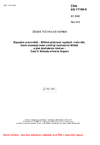ČSN EN 17199-5 (833642)
Expozice pracoviště - Měření prašnosti sypkých materiálů, které obsahují nebo uvolňují dýchatelný NOAA a jiné dýchatelné částice - Část 5: Metoda vířivého třepání
Anotace obsahu normy
This document describes the methodology for measuring and characterizing the dustiness of bulk materials that contain or release respirable NOAA or other respirable particles, under standard and reproducible conditions and specifies for that purpose the vortex shaker method.
This document specifies the selection of instruments and devices and the procedures for calculating and presenting the results. It also gives guidelines on the evaluation and reporting of the data.
The methodology described in this document enables
a) the measurement of the respirable dustiness mass fraction,
b) the measurement of the number-based dustiness index of respirable particles in the particle size range from about 10 nm to about 1 µm,
c) the measurement of the number-based emission rate of respirable particles in the particle size range from about 10 nm to about 1 µm,
d) the measurement of the number-based particle size distribution of the released respirable aerosol in the particle size range from about 10 nm to 10 µm,
e) the collection of released airborne particles in the respirable fraction for subsequent observations and analysis by electron microscopy.
This document is applicable to the testing of a wide range of bulk materials including nanomaterials in powder form.
NOTE 1: With slightly different configurations of the method specified in this document, dustiness of a series of carbon nanotubes has been investigated ([5] to [10]). On the basis of this published work, it can be assumed that the vortex shaker method is also applicable to nanofibres and nanoplates.
This document is not applicable to millimetre-sized granules or pellets containing nano-objects in either unbound, bound uncoated and coated forms.
NOTE 2: The restrictions with regard to the application of the vortex shaker method on different kinds of nanomaterials result from the configuration of the vortex shaker apparatus as well as from the small size of the test sample required. Eventually, if future work will be able to provide accurate and repeatable data demonstrating that an extension of the method applicability is possible, the intention is to revise this document and to introduce further cases of method application.
NOTE 3: As observed in the pre-normative research project [4], the vortex shaker method specified in this document provides a more energetic aerosolization than the rotating drum, the continuous drop and the small rotating drum methods specified in EN 17199 2 [1], EN 17199 3 [2] and EN 17199 4 [3], respectively. The vortex shaker method can better simulate high energy dust dispersion operations or processes where vibration or shaking is applied or even describe a worst case scenario in a workplace, including the (non-recommended) practice of cleaning contaminated worker coveralls and dry work surfaces with compressed air.
NOTE 4: Currently no classification scheme in terms of dustiness indices or emission rates has been established according to the vortex shaker method. Eventually, when a large number of measurement data has been obtained, the intention is to revise the document and to introduce such a classification scheme, if applicable.
| Označení | ČSN EN 17199-5 (833642) |
|---|---|
| Katalogové číslo | 507925 |
| Cena | 440 Kč440 |
| Datum schválení | 1. 10. 2019 |
| Datum účinnosti | 1. 11. 2019 |
| Jazyk | angličtina (obsahuje pouze anglický originál) |
| Počet stran | 40 stran formátu A4 |
| EAN kód | 8596135079254 |
| Dostupnost | skladem (tisk na počkání) |
Další příbuzné normy
ČSN EN 17199-1 (833642)
Expozice pracoviště - Měření prašnosti sypkých materiálů, které obsahují nebo uvolňují dýchatelný NOAA a jiné dýchatelné částice - Část 1: Požadavky a volba zkušebních metod
ČSN EN 17199-2 (833642)
Expozice pracoviště - Měření prašnosti sypkých materiálů, které obsahují nebo uvolňují dýchatelný NOAA a jiné dýchatelné částice - Část 2: Metoda rotačního bubnu
ČSN EN 17199-3 (833642)
Expozice pracoviště - Měření prašnosti sypkých materiálů, které obsahují nebo uvolňují dýchatelný NOAA a jiné dýchatelné částice - Část 3: Metoda kontinuálního poklesu
ČSN EN 17199-4 (833642)
Expozice pracoviště - Měření prašnosti sypkých materiálů, které obsahují nebo uvolňují dýchatelný NOAA a jiné dýchatelné částice - Část 4: Metoda malé rotace bubnu


